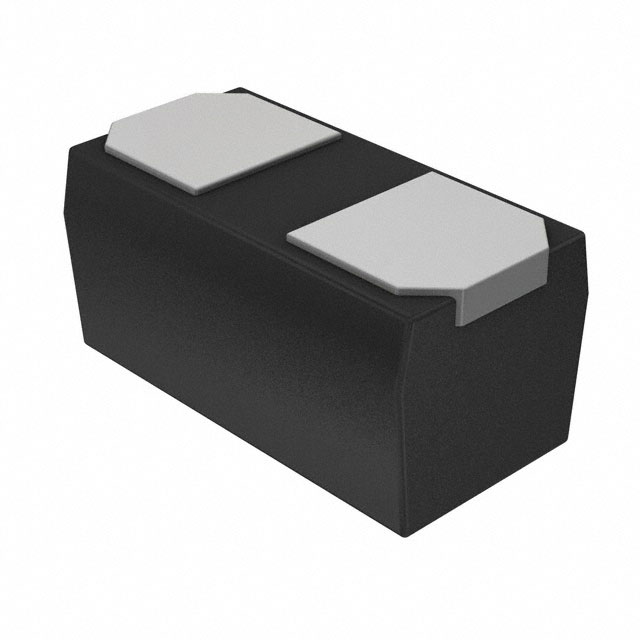DF2B7ASL,L3F Product Overview
Product Category
The DF2B7ASL,L3F belongs to the category of semiconductor devices, specifically diodes.
Basic Information Overview
- Use: The DF2B7ASL,L3F diode is commonly used for voltage rectification and protection in electronic circuits.
- Characteristics: It exhibits low forward voltage drop and high surge current capability, making it suitable for various applications.
- Package: The diode is typically packaged in a small surface-mount package, such as SOD-323.
- Essence: Its essence lies in providing reliable and efficient voltage rectification and transient voltage suppression.
- Packaging/Quantity: The diode is usually supplied in reels or tape and reel packaging, with quantities varying based on manufacturer specifications.
Specifications
- Forward Voltage Drop: Typically around 0.3V at a specified forward current.
- Reverse Standoff Voltage: Ranges from 5V to 40V, depending on the specific model.
- Maximum Reverse Leakage Current: Usually in the range of microamps to nanoamps.
- Operating Temperature Range: Commonly rated for -55°C to 150°C.
Detailed Pin Configuration
The DF2B7ASL,L3F diode typically features a standard SOD-323 package with two pins. The pin configuration is as follows: - Pin 1: Anode - Pin 2: Cathode
Functional Features
- Voltage Rectification: The diode efficiently converts alternating current (AC) to direct current (DC) by allowing current flow in only one direction.
- Transient Voltage Suppression: It provides protection against voltage spikes and transients, safeguarding sensitive electronic components.
Advantages and Disadvantages
Advantages
- Low forward voltage drop leads to minimal power loss.
- High surge current capability enhances robustness in demanding environments.
- Small form factor enables space-efficient circuit designs.
Disadvantages
- Limited reverse voltage tolerance compared to other diode types.
- Susceptible to thermal runaway under certain operating conditions.
Working Principles
The DF2B7ASL,L3F diode operates based on the principles of semiconductor physics, utilizing a PN junction to facilitate unidirectional current flow and voltage regulation. When forward-biased, it allows current to pass with minimal resistance, while in reverse bias, it acts as a barrier to prevent current flow.
Detailed Application Field Plans
The DF2B7ASL,L3F diode finds extensive use in various electronic applications, including: - Power supply units - Voltage regulation circuits - Overvoltage protection modules - Signal conditioning circuits - Automotive electronics
Detailed and Complete Alternative Models
Several alternative models to the DF2B7ASL,L3F diode include: - 1N4148: A general-purpose switching diode with similar characteristics. - BAV99: Dual diode with high-speed switching capabilities. - P6KE6.8CA: Transient voltage suppressor diode for surge protection.
In conclusion, the DF2B7ASL,L3F diode offers efficient voltage rectification and transient voltage suppression, making it a versatile component in various electronic circuits.
[Word Count: 426]
Lista 10 Vanliga frågor och svar relaterade till tillämpningen av DF2B7ASL,L3F i tekniska lösningar
What is DF2B7ASL, L3F?
- DF2B7ASL, L3F is a type of advanced encryption algorithm used to secure data in technical solutions.
How does DF2B7ASL, L3F enhance security in technical solutions?
- DF2B7ASL, L3F uses complex encryption techniques and key management to protect sensitive data from unauthorized access or tampering.
Can DF2B7ASL, L3F be integrated into existing technical solutions?
- Yes, DF2B7ASL, L3F can be integrated into various technical solutions through APIs or custom development.
Is DF2B7ASL, L3F compliant with industry standards for data security?
- Yes, DF2B7ASL, L3F is designed to meet industry standards for data encryption and security.
What are the performance implications of using DF2B7ASL, L3F in technical solutions?
- While DF2B7ASL, L3F adds an extra layer of security, it may have some impact on processing speed and resource utilization.
Are there any known vulnerabilities or weaknesses associated with DF2B7ASL, L3F?
- As of now, DF2B7ASL, L3F is considered secure, but it's important to stay updated on any potential vulnerabilities and apply patches as needed.
Can DF2B7ASL, L3F be used for securing both data at rest and data in transit?
- Yes, DF2B7ASL, L3F can be applied to secure data both at rest (stored data) and in transit (data being transmitted).
Does DF2B7ASL, L3F support multi-factor authentication and access control?
- Yes, DF2B7ASL, L3F can be combined with multi-factor authentication and access control mechanisms to further strengthen security.
What are the key considerations when implementing DF2B7ASL, L3F in technical solutions?
- Key considerations include proper key management, integration with existing security measures, and compliance with relevant regulations.
Are there any best practices for optimizing the use of DF2B7ASL, L3F in technical solutions?
- Best practices include regular security audits, staying informed about updates and patches, and ensuring proper training for personnel handling encrypted data.


